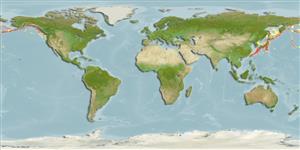Environment: milieu / climate zone / depth range / distribution range
Ecologia
marino benthopelagico; distribuzione batimetrica 612 - 1700 m (Ref. 50550). Temperate; 66°N -
North Pacific: Pusan, Korea north (outside the Sea of Okhotsk) to Providence Bay in the Anadyr Gulf of the Bering Sea, throughout the Aleutian Basin and islands, and southeast to Mathieson Channel, British Columbia, Canada.
Size / Peso / Age
Maturity: Lm ? range ? - ? cm
Max length : 41.0 cm TL maschio/sesso non determinato; (Ref. 56527); peso massimo pubblicato: 2.3 kg (Ref. 56527)
Spine dorsali (totale): 0; Raggi dorsali molli (totale): 8-9; Spine anali 0; Raggi anali molli: 7 - 9. Brownish gray with dark spots dorsally, muddy gray ventrally. Caudal fin rounded; pectoral fins large and broadly based; pelvic fins modified to form a clinging disc with a thickened margin on the ventral surface of the body (Ref. 6885). Skin naked without scales and tubercles. First dorsal fin completely embedded under the skin. Disk rudimentary in young, well developed in adults (Ref. 43939).
Males are said to guard the eggs (Ref. 6885). Migrate to spawn in littoral waters of Bering Sea in December-June (Ref. 43939).
Life cycle and mating behavior
Maturità | Riproduzione | Deposizione | Uova | Fecundity | Larve
Eschmeyer, W.N., E.S. Herald and H. Hammann, 1983. A field guide to Pacific coast fishes of North America. Boston (MA, USA): Houghton Mifflin Company. xii+336 p. (Ref. 2850)
IUCN Red List Status (Ref. 130435)
Threat to humans
Harmless
Human uses
Informazioni ulteriori
BibliografiaAcquacolturaProfilo di acquacolturaVarietàGeneticaElectrophoresesEreditarietàMalattieElaborazioneNutrientsMass conversion
CollaboratoriImmaginiStamps, Coins Misc.SuoniCiguateraVelocitàModalità di nuotoArea branchialeOtolithsCervelliVista
Strumenti
Special reports
Download XML
Fonti Internet
Estimates based on models
Preferred temperature (Ref.
123201): 2.3 - 4.6, mean 2.8 °C (based on 159 cells).
Phylogenetic diversity index (Ref.
82804): PD
50 = 1.0000 [Uniqueness, from 0.5 = low to 2.0 = high].
Bayesian length-weight: a=0.01995 (0.00906 - 0.04395), b=3.01 (2.83 - 3.19), in cm total length, based on all LWR estimates for this body shape (Ref.
93245).
Trophic level (Ref.
69278): 3.7 ±0.38 se; based on food items.
Resilienza (Ref.
120179): Medio, tempo minimo di raddoppiamento della popolazione 1.4 - 4.4 anni (Preliminary K or Fecundity.).
Fishing Vulnerability (Ref.
59153): Low to moderate vulnerability (31 of 100).
